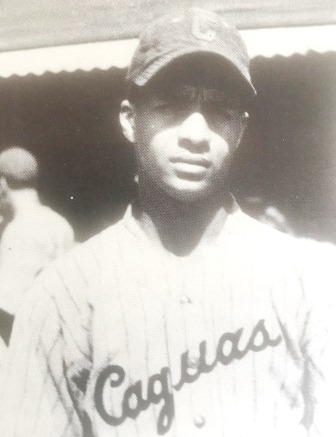
Roy Campanella was reading a newspaper in Puerto Rico and listening to music on the radio, Sunday, December 7, 1941, prior to a Caguas Criollos-Santurce Crabbers morning-afternoon twin-bill, when a bulletin in Spanish suddenly interrupted the music. Pearl Harbor had been bombed by the Japanese Air Force. Puerto Rico Winter League (PRWL) games were played that Sunday; Campanella recalled that Caguas won both contests. The future Cooperstown Hall of Famer was already a beloved hero in Caguas, due to hitting a grand slam HR off Santurce ace Luis Rafael Cabrera aka “Cabrerita” in Game Six of the 1940-41 Final Series, a series won by the Criollos in seven games. Campanella became fairly proficient in Spanish, due to his winter seasons in Puerto Rico and Venezuela, plus playing summer baseball in Mexico. He was the first ex-Caguas Criollos player elected to Cooperstown, in 1969.

Luis R. Olmo, Campanella’s Caguas teammate, 1940-42, and “Campy’s” future teammate with the 1949 NL Champion Brooklyn Dodgers, was also held in high esteem by the Criollos rabid baseball fans. Olmo, a native of Arecibo, Puerto Rico, married Emma Paradis, from Caguas, October 27, 1940, nearly two years after making his Caguas debut on November 13, 1938, as a 19-year-old OF, with a .335 AVG. (The Puerto Rico Semi-Pro League began in 1938-39 with six teams; by 1941-42 it had eight ballclubs). Olmo was Puerto Rico’s first position player to play MLB, for the 1943 Brooklyn Dodgers. Hiram Bithorn Sosa, a pitcher, preceded Olmo, with the 1942 Chicago Cubs. “I made seven dollars a week with the [1938-39] Criollos,” related Olmo to the author. “I became a good friend of Campanella…” Olmo also befriended Joe DiMaggio, and played golf with the “Yankee Clipper,” a few times.
Criollos from 1938-49 through 1948-49
Caguas won two league titles, 1940-41 and 1947-48, pre-Caribbean Series, a regional event first hosted by Havana, Cuba, February 20-25, 1949. Billy Byrd (15-5) was their 1940-41 ace, with Campanella catching. Campanella’s eight HR tied Buck Leonard of Mayagüez, for the league lead. The 1947-48 Criollos featured player-manager Quincy Trouppe, an excellent catcher with a .320 AVG; 2B Lorenzo “Piper” Davis’s 10 HR and 51 RBI in a 60-game season, equivalent to 27 HR and 138 RBI in 162 games; and OF Juan “Tetelo” Vargas, from the Dominican Republic. Vargas played in Puerto Rico as a native, and was called the “Dominican Deer,” (El Gamo Dominicano). He had starred for the two-time league champion Guayama Witches (1938-39 and 1939-40), and was Satchel Paige’s 1939-40 Guayama teammate. Caguas merged with the Santurce Crabbers, 1942-43 through 1945-46 due to World War II austerity measures.
Table I: Caguas Criollos All-Star Team, 1938-39 to 1948-49, per historian Héctor Barea
| Player-Position | Season | Caguas Season Highlights |
| Roy Campanella-C | 1940-41 | Co-leader 8 HR, 1940-41; Grand Slam off “Cabrerita” |
| Quincy Trouppe-C | 1947-48 | .320 AVG; won league title as player-manager |
| Sammy Céspedes-1B | 1941-42 | .364 AVG; sure-handed 1B |
| Piper Davis-2B | 1948-49 | 66 RBI in 80-game season; 51 RBI in 1947-48 (60 G) |
| Radamés López-3B | 1947-48 | .298 AVG; real name was Fulgencio Fajardo |
| Buster Clarkson-SS | 1946-47 | .320 AVG, 13 HR, 48 RBI, 60-game season |
| Leonard Pearson-SS | 1940-41 | .360 AVG, outstanding defensively for champions |
| Manolo García-OF | 1940-41 | .281 AVG, excellent CF on franchise’s first champion |
| Luis R. Olmo-OF | 1938-39 | .335 AVG (1938-39); 10 triples (1940-41) |
| Tetelo Vargas-OF | 1946-47 | .382 AVG, future (1953-54) teammate of Hank Aaron |
| Dan Bankhead-P | 1946-47 | 12-8 W-L, league-leading 179 strikeouts |
| Billy Byrd-P | 1940-41 | 15-5 W-L, fabulous knuckle ball |
| Rafaelito Ortiz-P | 1946-47 | 12-6 W-L, “El Mago de las Magas” |
Ford C. Frick Award Recipients and Puerto Rico’s Winter League
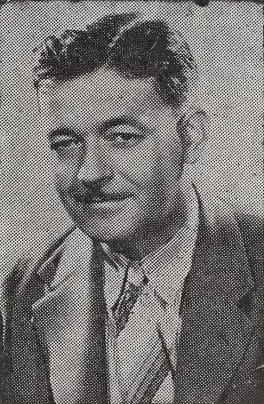
Buck Canel, born in Argentina, broadcast big league games from 1936-to-1979 and was the only Spanish-speaking broadcaster to work the inaugural Hall of Fame ceremonies from Cooperstown, June 1939. Canel did radio broadcast work for the Caguas Criollos, for three winter seasons, 1947-early 1950. One of his favorite phrases, per Santurce fan Charles Ferrer, was “El Pantano Iluminado” (the Lighted Swamp), as he called the Caguas playing field—José Gautier Benítez Park, 1947-49, and Ydelfonso Solá Morales Stadium, 1949-50—after another thunderstorm. Canel was awarded the 1985 Ford C. Frick Award by the National Baseball Hall of Fame and Museum. Thus, he became the first broadcaster with a Puerto Rico Winter League connection to be so honored. Phil Rizzuto did radio broadcast work for the 1960-61 San Juan Senators, but he is enshrined in Cooperstown via a 1994 Veterans Committee selection. Felo Ramírez, originally from Cuba, relocated to Puerto Rico, and did broadcast work for San Juan, Santurce and Arecibo. He was a 2001 Ford C. Frick Award winner, two years prior to Bob Uecker’s 2003 selection. Uecker played for the 1961-62 Arecibo Wolves, under skipper Luis R. Olmo. “Mister Baseball” remembered Olmo as a “good fellow” who spoke “perfect English.”
Criollos Highlights: 1950 Caribbean Series-December 30, 1956
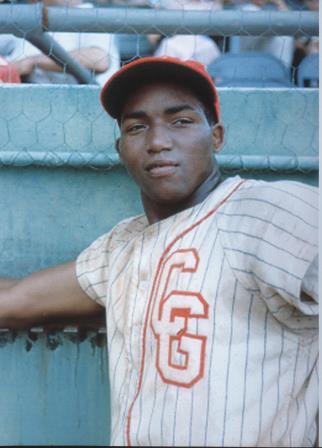
Caguas’s 1950-51 club finished 57-20, .740, under player-manager Olmo for the most regular season wins in league history, after playing in their first (February 1950) Caribbean Series. The Criollos were bested by the Carta Vieja Yankees of Panamá in a tie-breaker, for this (February 1950) title. The following (1950-51) winter, they lost to the Crabbers in a seven-game Final Series, after sweeping the San Juan Senators, four games-to-none, in the Semis. “That [1950-51] Caguas team was the most dominant one I ever played on,” stated Víctor (Vic) Pellot Power, the star 1B, who also played 3B and other positions. Coincidentally, Power—like Olmo—was also born in Arecibo. It took a February 16, 1951 walk-off HR by Santurce 1B Pepe Lucas (José St. Claire) to dethrone Caguas, who had won the 1949-50 league crown. “The Shot Heard Around Puerto Rico” preceded Bobby Thomson’s October 3, 1951 walk-off HR for the New York Giants versus the Brooklyn Dodgers.

Bert Thiel, a teammate of Luis R. Olmo with the 1951 Milwaukee Brewers, winners of the Junior World Series versus the Montreal Royals, reinforced the 1951-52 Criollos, thanks to Olmo’s suggestion. Thiel won 14 of Caguas’s 42 games in 1951-52. He was allowed to travel to away games in Ponce and Mayagüez in a used Cadillac with Billy Klaus and Murray Wall. “Luis just wanted to make sure we got to the games on time,” said Thiel. “We respected and liked [player-manager] Luis—a great guy.” Thiel won a bunch of cases of Don Q rum, but had to leave them behind when the season ended.
Mickey Owen Takes Charge, 1953-54
Mickey Owen, who caught for Brooklyn in the 1941 World Series, against the New York Yankees, and became known for a ninth-inning passed ball in that Series, had success as 1953-54 Caguas player-manager, in an 80-game season with five teams. On January 13, 1954, Owen activated himself for the stretch run when his Criollos trailed first-place San Juan by five games. Caguas won 15 of their last 17 games to finish first at 46-34, four games ahead of San Juan. “Brooks Lawrence was the best pitcher on our staff; he could start or relieve,” said Owen. “He was the reason I went back to catching. Lawrence moved the ball around the plate with a sliding curve and a big curveball and Guigui Lucas (Pepe Lucas’s brother) felt uncomfortable catching certain pitches. Guigui was a character—he carried his money and even a paycheck in his back pocket. He had played in lots of places where money was taken from locker rooms.”
Caguas pitchers Bob Buhl and Ray Crone performed superbly with Owen catching. Crone, who joined the team in December 1953 and finished with a 6-1 record, said there was a certain chemistry between them and Owen brought out (Crone’s) best. Owen, earlier that winter season, helped 19-year-old Hank Aaron make a successful transition from 2B to RF. Aaron was not playing well at 2B for Caguas. “I knew where I could get a better 2B than Aaron, [but] he could sure hit,” noted Owen to the author. “So, one day I hit him [Aaron] a few flyballs and he went to it and got them easy, and he threw good. I said, you’re not an infielder, you’re an outfielder.”

Owen secured Charley Neal to play 2B, and the rest is history. Neal had been the second sacker for Newport News in the 1953 Piedmont League and Owen had gotten a good look at him while managing Norfolk to Piedmont’s title. When Neal teamed with Aaron’s buddy, shortstop Félix Mantilla, in the middle of Caguas’s infield, Aaron went to RF. Owen: “I never told Aaron how to do anything except once I told him to hit one to RF, and he hit a bullet there. Aaron said I helped him hit to right, but all I really did was urge him to hit the ball there.” It should be mentioned that Luis Olmo was a scout for the Milwaukee (and 1951-53 Boston) Braves, and was instrumental in securing the permission of the Braves in sending Aaron and other imports to Caguas, as well as getting Félix Mantilla to play for the 1953-54 Criollos.
Aaron served notice that he was for real by tying for the Puerto Rico HR title (nine) with teammate Jim Rivera. He (Aaron) finished third in the batting chase at .322, behind Island legend Luis Angel “Canena” Márquez (.333 AVG for Mayagüez) and Chuck Harmon’s .325 AVG for the Ponce Lions. Aaron has fond recollections of his two HR in the League All-Star Game and being named its MVP. His first child was born in Puerto Rico, another reason Puerto Rico has sentimental value for the right-handed hitter with the most (755) HR in MLB history, and top career RBI producer (2,297) of all MLB players.
February 18-23, 1954 Caribbean Series
When it came time to reinforce the Criollos for the February 1954 Caribbean Series at Sixto Escobar Stadium, in San Juan, Puerto Rico, Aaron—who departed for the States after Caguas bested Mayagüez in the Finals—was replaced on the roster by Bill Howerton, Mayagüez Indians RF. “I had been released by Cuba’s Marianao team early that [1953-54] season,” said Howerton. “But I could always hit.” Howerton then signed with Mayagüez and got noticed by Owen and the Caguas management with his work ethic and hitting ability. Owen was involved in the decision to replace LF Tetelo Vargas in the Caribbean Series line-up with Mayagüez’s Carlos Bernier, who played his only MLB season with the 1953 Pittsburgh Pirates. The other option was Roberto Clemente, 19-year-old LF for Santurce, with a .288 AVG. Bernier, at the time, was a big leaguer, and held the Puerto Rico League’s single-season SB record (41), set for Mayagüez, 1949-50. Clemente played LF for Santurce since Bob Thurman, the RF and part-time pitcher, had the “stronger and more accurate throwing arm” in the mid-1950s. So, Bernier reinforced Caguas.
Caguas also reinforced itself (a common practice for Caribbean Series participants) with pitchers Rubén Gómez of Santurce, Luis “Tite” Arroyo and Jack Sanford of Ponce; and Mayagüez’s Corky Valentine. San Juan’s Jack Cassini replaced the departed Charley Neal at 2B. Gómez won his start, 3-2, versus Venezuela’s Pastora Milkers, on February 20, fanning 10 hitters with his screwball. The series’ pivotal moment came in Game Three versus Almendares, the Cuban entry, on February 21, 1954. Caguas trailed, 1-0, in the top of the seventh, when Howerton drilled a Cliff Fannin fastball over the right-field fence at Escobar, to knot the score. Rafael Pont Flores, a diehard Santurce fan and sportswriter, described it: “Angel Scull put on wings going after Howerton’s blast. The fans put hands to their eyes like a sentry on the top of a pose. Noise erupted from the stands which never, never stopped. When the import [Howerton] crossed the plate, he was received like a famous native who has been absent from the country a long time.”
Then, 3B Rance Pless cracked a two-run HR to give Caguas a 3-1 lead and, eventually, the win. Pont Flores: “Hankies, coats, and ties were waved in the air by these happy lunatics. Pless took his time rounding the bases. A priest was waving his hankie—if that wasn’t a blessing.”
Billy Howerton Jr., age eight at the time, attended this game with his mother. Howerton Jr. never forgot those moments. “The fans began to torch newspapers and anything they could lay their hands on. It was like a huge bonfire. After the game I remember my father being interviewed for several radio stations. He received gift certificates.”
Rance Pless will never forget this experience, either. “The crowd went crazy. After we won the series, there were parades and we were serenaded all night long. I went up to the plaza and gave a speech…[I was] given a portable television and other gifts. Winning that Caribbean Series meant a lot to us. Heck, the fans were passed out everywhere the next morning.”
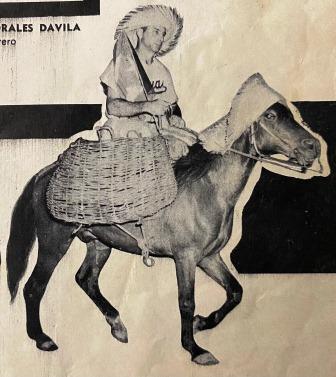
Corky Valentine won his start, and Tite Arroyo (1-0) pitched 7.1 flawless innings. When Caguas clinched the title on February 22, 1953, with a 4-1 record, Owen was given the flag of Puerto Rico and asked to get on the team mascot, a yeguita (filly), for a victory lap at Escobar Stadium. Owen remembered this episode more vividly than Caguas’s four wins. “I didn’t have a big-league managing career, but that Puerto Rico experience helped me get back to the big leagues with the Boston Red Sox,” recalled Owen. “They signed me as a player-coach in 1954 and full-time coach in 1955 and 1956. Joe Cronin and Tom Yawkey saw me catch and manage in Puerto Rico, and I was catching well there.”
Caguas lost Game Six to Almendares, in finishing 4-2, one game ahead of Almendares and Panamá’s Carta Vieja Yankees. Pastora finished 2-4. Jim Rivera (.450 AVG) was Series MVP. He was the All-Star CF. Vic Power (1B) and Jack Cassini (2B) were named to this select squad.
February 10-15, 1956 Caribbean Series
Caguas returned to the Caribbean Series two years later, at Olympic Stadium, Panamá City, Panamá. The Criollos bested defending 1955 Caribbean Series champion Santurce, four games-to-two, in the 1955-56 Puerto Rico League finals, helped by Tom Lasorda’s pitching and Lou Limmer’s hitting. Limmer had been suspended from Caribbean Winter League baseball for five years, due to a December 1950 “escape” from Aguadilla, Puerto Rico. Limmer took a publico (jitney) from Aguadilla to the San Juan airport in the early morning hours, after receiving some back pay. Thus, the Caribbean Confederation banished him from winter ball for five seasons. He atoned for this by his clutch hitting for Caguas in the 1955=56 post-season. Limmer went seven-for-20 (.350 AVG) in February’s 1956 Caribbean Series, with three HR and eight RBI; he was chosen as the Series All-Star 1B, an honor shared by 3B Vic Power. However, Cuba’s Cienfuegos Elephants (5-1) were too powerful for Caguas (3-3), Panamá’s Chesterfield Smokers (3-3) and the Valencia Industrialists (1-5). Camilo Pascual (2-0) and Pedro Ramos (2-0) won four of Cuba’s five victories.
Sandy Koufax, Bob Thurman, Jim Landis and Roberto Clemente Intersect, 1956-57

Sandy Koufax was a 20-year-old LHP with control issues when he joined the 1956-57 Caguas-Rio Piedras Criollos after two seasons with the Brooklyn Dodgers. The franchise’s name change was marketing-related. Caguas wanted to appeal to fans in the Rio Piedras section of San Juan, where the University of Puerto Rico is located. Hence, the name change to Caguas-RP. Santurce veteran Bob Thurman observed Koufax’s pitching motion in 1955 and 1956 NL seasons and in Puerto Rico, mid-October-to-mid-December 1956. Thurman told the author that he would tease Koufax about his velocity. “Koufax could throw that ball. I felt he might have elbow problems by the way his follow-through went and the elbow staying up—pushing that elbow out would cause a terrible strain. I had a loosey-goosey delivery; otherwise, I’d have arm problems.”
Koufax’s last game in Puerto Rico was a 2-0 SHO versus Santurce, December 16, 1956. The only two hits he allowed were to 22-year-old Roberto Clemente, in the midst of his 23-consecutive game hitting streak. By a strange turn of events, this was Koufax’s Puerto Rico swan song, due to a newly implemented league rule limiting the number of major leaguers on Puerto Rico’s rosters to three players. Kermit Schmidt was a rookie league umpire from Ponce who called several of Koufax’s games for Caguas-RP. Schmidt, who became a pharmacist, was impressed by Koufax’s velocity. Jim Landis, who played for Caguas and San Juan, 1956-57, spent some time with Koufax and reliever Ryne Duren doing night fishing at the pier near the Normandie Apartments, located across from Escobar Stadium, where the trio lived.
Caguas Acquires Roberto Clemente, Juan Pizarro and Ronnie Samford



Part I concludes with the December 30, 1956 sale of three Santurce players—Roberto Clemente, LHP Juan “Terín” Pizarro and 2B Ronnie Samford—to Caguas, in a $30,000 transaction. Simply put, Santurce owner Pedrín Zorrilla had recently transfer his team to Ramón Cuevas. Mr. Cuevas, in turn, faced a $30,000 debt, one which he quickly eliminated by selling two local stars (Clemente and Pizarro) plus one import (Samford) to the rival Caguas-RP Criollos. Ramón Cuevas entered the visitors’ clubhouse at Mayagüez to announce this December 30, 1956 sale. Rubén Gómez was so livid he took off his uniform, stormed out of the clubhouse and drove home. Ironically, Gómez was such a good athlete that he replaced Clemente in the Santurce outfield. Years later, Marcial “Canenita” Allen tearfully recalled Clemente’s reaction. “Roberto told me to grab the stuff,” said Allen. “You’re coming to Caguas with me. He [Roberto] was a brother and a friend.”
With deep appreciation to Marcial “Canenita” Allen, Héctor Barea, Rubén Gómez, Bill Howerton Sr. and Jr., Jim Landis, Tom Lasorda, Lou Limmer, Luis R. Olmo, Mickey Owen, Rance Pless, Vic Power, Kermit Schmidt, Bert Thiel, Bob Thurman and Bob Uecker. Thanks to Jorge Colón Delgado, Official Historian, Roberto Clemente Professional Baseball League.
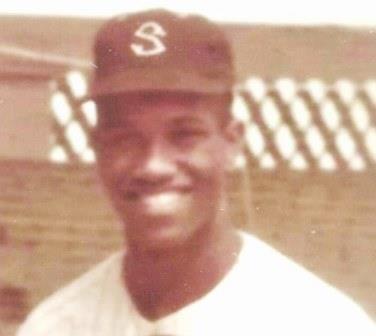
Wao excelente artículo de nuestro béisbol gracias por mantenernos bien informado de este rico y puro béisbol del ayer con sus grandes glorias
Pingback: Remembering Hank Aaron’s remarkable 1953-54 season in Puerto Rico |
Un historial muy informativo para los que crecieron con estos atletas historicos en esos anos cuando no habia los lujos y protectores que los atletas de hoy usan para prolongar sus carreras. Yo tuve la suerte te ver varios de los mencionados aqui cuando nino y lluego joven fanatico en Puerto Rico.